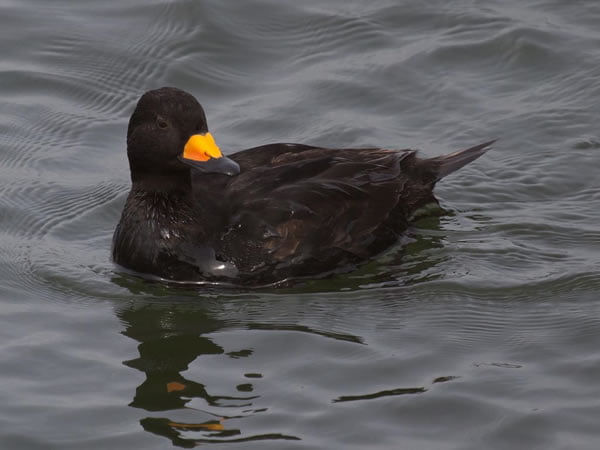Year Funded: 2002 (year endorsed)
Lead Institution(s): USGS Alaska Science Center
Collaborator(s): Fred Broerman (USFWS), Jason Schamber (USGS), USFWS, MBM
Focal Species: Black Scoter (Melanitta americana)
Project Description: In 2001, a study of the ecology of breeding Black Scoters was initiated at Aropuk Lake on the Yukon-Kuskokwim Delta, Alaska. Initial results indicate that Black Scoter females initiate nesting in mid-June, with peak incubation occurring in early to mid-July. In contrast to other species of waterfowl, pairs did not appear to establish and maintain territories; therefore, there was no discernable association between the distribution of Black Scoter pairs during egg laying and the ultimate distribution of nests. Further, pairs appeared to dissolve in late June and single males were rarely observed on the study area. Thus, the utility of data collected in conjunction with aerial surveys designed for other species of ducks is questionable for indexing population size and breeding distribution of Black Scoters. Finally, recent studies attempting to link wintering populations of Surf and White-winged Scoters with breeding locations using satellite telemetry have documented very high mortality of scoters fitted with implanted transmitters. It is unclear if the high mortality experienced in these studies is associated with timing of marking (i.e., winter) or if something unique about the morphology of scoters precludes the use of implanted transmitters.
We examined the spatial and temporal patterns of movement of male Black Scoters captured and implanted with intra-abdominal VHF radio transmitters at Aropuk Lake. Additionally, we monitored survival of implanted individuals to assess the impact of surgical procedures and determine the feasibility of future satellite transmitter use in Black Scoters. Objectives include: 1) Determine timing and patterns of movement of breeding Black Scoter males to allow interpretation of aerial survey data relative to population size and breeding phenology, and 2) Assess the impact of surgical procedures and implanted transmitters on the survival of male Black Scoters during the breeding season. This information will be applied to future decision-making concerning use of satellite transmitters in this species.
SDJV22 Interim Report FY02
Related Publications
Bowman, T.D., S.G. Gilliland, J.L. Schamber, P.L. Flint, D. Esler, W.S. Boyd, D.H. Rosenberg, J-P.L. Savard, M.C. Perry, and J.E. Osenkowski. 2021. Strong evidence for two disjunct populations of Black Scoters (Melanitta americana) in North America. Wildfowl 71:179-192. https://wildfowl.wwt.org.uk/index.php/wildfowl/article/view/2759/0
Bianchini, K., S.G. Gilliland, A.M. Berlin, T.D. Bowman, W.S. Boyd, S.E.W. De La Cruz, D. Esler, J.R. Evenson, P.L. Flint, K. Kenow, C. Lepage, P.H. Loring, S.R. McWilliams, D.E. Meattey, J.E. Osenkowski, M.C. Perry, J-F. Poulin, E. Reed, C. Roy, J-P.L. Savard, L. Savoy, J.L. Schamber, C.S. Spiegel, J. Takekawa, D.H. Ward, and M.L. Mallory. 2023. Continental scoter breeding chronology and distribution. Wildlife Biology. https://doi.org/10.1002/wlb3.01099
Lamb, J.S., C. Cooper-Mullin, S.G. Gilliland, A.M. Berlin, T.D. Bowman, W.S. Boyd, S.E.W. De La Cruz, D. Esler, J.R. Evenson, P.L. Flint, C. Lepage, J.E. Osenkowski, P.W.C. Paton, M.C. Perry, D. Rosenberg, J-P.L. Savard, L. Savoy, J. Schamber, C.S. Spiegel, D.H. Ward, J.Y. Takekawa, and S.R. McWilliams. 2024. Evaluating conservation units using network analysis: A sea duck case study. Frontiers in Ecology and the Environment. https://doi.org/10.1002/fee.2648
